|
FAQs on Parasitic Marine Worm
Diseases 3
Related Articles: Marine
Parasitic Disease, Parasitic
Worms, Roundworms,
Related FAQs: Fish Worm Diseases 1, Marine Worm Parasites 2,
& FAQs on Marine Worm Parasites: Diagnosis/Symptomology, Etiology/Prevention, Cures That Don't Work, Cures That Do Work, Products/Manufacturers... Flukes/Trematodes, Tapeworms/Cestodes, Leeches/Hirudineans, "Other" Worms and Worm-Like
Parasites... Paravortex/Black
Spot Disease, Anthelminthics/Vermifuges... De-wormers
(Piperazine, Praziquantel...) & FAQs, Yellow
Tang Disease, Parasitic Disease 2, Parasitic Disease 3, Parasitic Marine Tanks, Parasitic Reef Tanks,
Cryptocaryoniasis, Marine
Ich, Marine Velvet Disease Biological Cleaners,
Treating Parasitic Disease,
Using Hyposalinity to Treat
Parasitic Disease, Roundworms,
Yellow Tangs, Tang Health/Disease,
|
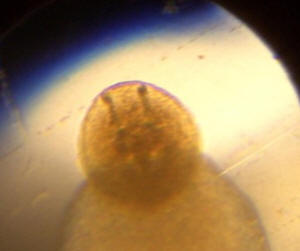
|
|
Gill worm / flukes /RMF 2/5/19
Dear Bob,
<Branko>
Flukes are back and this time they mean vengeance, we successfully eliminated
them last summer with General cure, however we dont have access to it anymore
and would take 45-60 days to get more. :(
<Ohhh>
We are struggling with Sera Tremazol (only stock solution available here), their
recommended dose is slightly less than 5mg / l, while you recommended 20mg/l in
one of the articles on WWM.
<Yes>
Additionally, while browsing online I've found one more method: " Another method
that can be used for capsalid Monogeneans is hyposalinity. In one study, 15 g/L
(ppt) salinity or lower for two days eliminated juvenile and adult Neobenedenia
melleni. When 15 g/L was maintained for 5 days, the hatching of N. melleni eggs
was prevented. It is important to note that some fish species may not tolerate
this treatment method. " Will this kill eggs within 5 days, or they will hatch
once salinity is brought up to normal?
<I don't know; but am concerned here. MIGHT it be worth "nuking" the system
(bleach, possibly formalin...) and bathing/dipping all fishes (formalin, pH
adjusted freshwater), to get rid of adult forms?>
This currently looks rather appealing to me, since it's easiest to administer.
Additionally, we would setup a bath for all fish and put them through it, in
order to eliminate adult specimens and relieve fish of pest
while let hypo do the work on the eggs/remaining flukes.
<Good>
We have already dipped all fish through 5-7mins Freshwater with adjusted pH +
Tremazol + Furan2 dip, we've clearly seen flukes coming off. Fish looked
relieved for short period (24h) but now infestation is blooming again so we need
to deal with eggs in the system which are not controllable using Tremazol.
<Not fun>
In one of our emails, you have mentioned that some fish aren't tolerant to Hypo,
is there a list of those species which I could look at? Currently we have
Wrasse, Clownfish (not ocellaris), butterflies, tangs, angels both dwarf and
large, various watchmen gobies, blennies, Dottybacks, damselfish, file fish...
<Of those you list, Clownfish are the most sensitive. I WOULD watch, be present
while ALL are getting dipped>
If there is no list it would help if you could pin point those that aren't good
candidates for Hypo. Idea is to move fish that can't go into hypo to other
system where we would try to nuke it with high dose of
Tremazol to reach 20mg/l which you recommended.
Kind regards,
B.
<I wish you good fortune. Bob Fenner>
|
 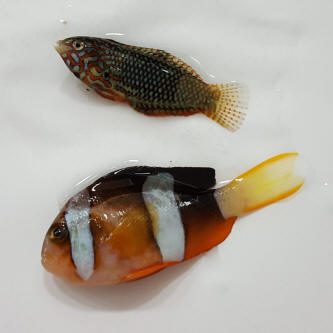 |
|
Re: Gill worm / flukes - 02/04/19 /Now Sara
Dear Bob,
<Sara L. here today.>
Flukes are back and this time they mean vengeance, we successfully eliminated
them last summer with General cure, however we dont have access to it anymore
and would take 45-60 days to get more. :(
We are struggling with Sera Tremazol (only stock solution available here), their
recommended dose is slightly less than 5mg / l, while you recommended 20mg/l in
one of the articles on WWM.
<So start with 5mg/l and see what happens. If that doesn't work, raise it to 8
mg/l, then 12 mg/l, etc.>
Additionally, while browsing online I've found one more method: " Another method
that can be used for capsalid Monogeneans is hyposalinity. In one study, 15 g/L
(ppt) salinity or lower for two days eliminated juvenile and adult Neobenedenia
melleni. When 15 g/L was maintained for 5 days, the hatching of N. melleni eggs
was prevented. It is important to note that some fish species may not tolerate
this treatment method. " Will this kill eggs within 5 days, or they will hatch
once salinity is brought up to normal?
<Possibly. I would have to read the study to know what the researcher/writer
meant by saying that the low salinity prevented the hatching of eggs.>
This currently looks rather appealing to me, since it's easiest to administer.
Additionally, we would setup a bath for all fish and put them through it, in
order to eliminate adult specimens and relieve fish of pest
while let hypo do the work on the eggs/remaining flukes.
We have already dipped all fish through 5-7mins Freshwater with adjusted pH +
Tremazol + Furan2 dip, we've clearly seen flukes coming off. Fish looked
relieved for short period (24h) but now infestation is blooming again so we need
to deal with eggs in the system which are not controllable using Tremazol.
<If what you're dealing with here is N. melleni, I wonder why the surviving fish
didn't develop an immunity to the parasite after the first prolonged exposure.>
In one of our emails, you have mentioned that some fish aren't tolerant to Hypo,
is there a list of those species which I could look at? Currently we have
Wrasse, Clownfish (not ocellaris), butterflies, tangs, angels both dwarf and
large, various watchmen gobies, blennies, Dottybacks, damselfish, file fish...
If there is no list it would help if you could pin point those that aren't good
candidates for Hypo.
<Hyposalinity will cause any and all marine fish a degree of stress. How much
stress any given fish can stand is dependent on so many variables.
Whatever you do, make sure you acclimate the fish to the reduced salinity
slowly.>
Idea is to move fish that can't go into hypo to other system where we would try
to nuke it with high dose of Tremazol to reach 20mg/l which you recommended.
<Unfortunately, in these situations, no one can tell you for certain what is
best to do. If I were in your position, I would first treat all the fish with
Tremazol. If you are unsure of the dose, start at 5 mg/l, then go to 8 mg/l,
etc. Unless this is a bare bottom, fish and live rock only system, I would not
apply hyposalinity to the system as a whole.>
Kind regards,
B.
<Cheers, Sara L.>
Re: Gill worm / flukes 2/5/19
Dear Sara,
Tremazol didn't work in suggested nor increased dosage. We applied doses twice
and we are still having issues fish are being eaten alive.
<What else have you tried?>
You will find quote regarding hyposalinity on this link on page 7:
http://fisheries.tamu.edu/files/2013/09/Monogenean-Parasites-of-Fish.pdf
<Wow. Great article. Unfortunately, it does not elaborate much on the use of
hyposalinity for treatment of marine fish. I don't know if hyposalinity kills
the eggs or not. Likely, if I had to guess, it probably damages them to the
point that a significant percentage of them will never hatch. That might be
sufficient to resolve the problem. Fish do have some ability to fight them off,
when not overwhelmed. As far as which of your fish might not tolerate
hyposalinity very well, again, it's hard to say. I would say
that any fish that is not known to be particularly hardy in captivity,
generally, is probably going to tolerate any sub-optimal condition less than the
more hardy species. The problem I see here is that you are going
to have to acclimate the fish to the hyposalinity, which will take at least days
and preferably weeks. If I'm understanding you correctly, it sounds like you
don't have that kind of time.>
I'm not sure which type of monogenean it is, but its killing off some of our
fish rather quickly, from the moment fish changes behavior its dead within 24h
with clear signs of being eaten, both on fins as well as head area, occasionally
there are open sores/wounds on the body as well. While other fish look perfect
and acting normally.
<Can you send in some pictures?>
All fish are in our 3600 liter quarantine system that's divided into boxes, each
box has its own drain which takes water down to central filtration unit, where
biological filtration and mechanical filtration are. Afterwards water is pumped
through the UV back into each box.
Water can't go between boxes, it has to go through drain>filtration>UV>into box.
While dosing Tremazol we did turn off UV and lowered skimmer foam so it doesn't
skim the medicine out.
Fish arrived from Bali, on 25th January, and we are battling flukes since day 2.
That's why we are in need of changing the method, this has proven to be
ineffective.
<The article you provided, from TAMU, mentions a lot of different treatment
options, one of which is copper. Have you tried copper in the quarantine system?
Cheers, Sara L.>
Re: Gill worm / flukes - 02/05/2019
Hello,
I explained what we tried, Tremazol dosed fully twice, and fw bath with
Nitrofurazone and Tremazol once.
<Yes, I saw. I was wondering if you had tried anything else. I see the answer is
no.>
As for the article itself, yes it does explains vaguely and im unsure if it
kills eggs was hoping you guys would know more about it :(
<The more I think about it, the more I think the article must be saying that 5
days of hyposalinity "killed" the eggs. Because if hyposalinity merely prevented
hatching, why would 5 days be required? The statement seems to imply that the
eggs still hatched if exposed to less than 5 days.
Thus, something must change after 5 days. The prolonged hyposalinity must cause
some damage to the eggs after that period of time. I wish we could tell you for
sure. It's not an easy thing to test/find out directly. The best anyone can do
is observe to see if the eggs hatch. I suppose that if they don't hatch, then
you might just as well assume they are "dead.">
As for copper, we do dose it to 0.12-0.14ppm for controlling possible protozoan
infestations, didn't try to raise the dose due to wrasse and Centropyge being in
this system, lastly article says copper can control but not kill flukes so im
keen on applying more efficient method with, preferably less stress to fish than
having 0.2 Cu.
<If all you need is 5 days of hyposalinity, maybe it's worth a shot. Again, my
only worry is that you don't have time to acclimate the fish slowly enough.
Tough choices.>
As for pictures here are couple i have on my phone.
<Yikes! I'm sorry you struggling with this. Do let us know if you use the
hyposalinity and if it works.
Cheers and good luck,
Sara L.>
Re: Gillworm / flukes - 02/05/2019
2/6/19
Hi,
We did fw + Tremazol double dose + Methylene blue 6-7 min dip on all fish
yesterday, lost only one since. (Already weakened meleagris leopard wrasse).
We started pumping freshwater in the system slowly, sg dropped 1022>1016 within
5 hours, we let it stay at 1016 overnight and are lowering it down to 1010
today. Plan is to do it over the course of 6 - 8 hours.
Fish look fairly better than yesterday, hiding less and overall looking more
active.
<Ah, good. Sometimes fish are pretty tough.>
Your conclusion regarding 5 days seems logical, i hope you are right. It would
make no sense to put fish through hypo if its not efficient, so i guess you are
right.
<::crossing fingers::>
Thanks for your continues effort in helping with this matter.
<I feel for you. I do hope all turns out well.>
B.
<Cheers,
Sara L.>
Re: Gillworm / flukes - 02/07/2019
2/7/19
Hi,
2 days straight no deaths. Dip+hypo definitely helped. I think its under
control now.
<Yay!>
Thanks a lot for your help.
<I'm not sure how much I helped, but you're certainly welcome.>
B.
<Cheers,
Sara L.>
|
|
To Marco- Help with Moray Eel disease
3/15/18
Hi!
<Hello Adrian.>
I could really need some help treat our infected moray eels. They have gotten a
blood sucking worm that only attacks the eels. It look like brown hairy looking
strings.
<Looks nasty. Can't definitely ID them, though.>
We have tried cleaner wrasse and shrimp and freshwater dip. My boss confirms its
not anchor worms and we don't have any medicine currently to treat it. The only
working solution we have found is removing it manually, but
they spread again after a short while.
<Can you get Flubenol 5% in Norway? (I think so) It's often used for e.g.
chickens or pigs as well as fishes and kills a wide range of internal and
external worms. Only use it in a hospital tank without sand (but some PVC pipes
as caves) or use it as baths/dips. Siphon the bottom of the tank for any eggs
(or cysts depending on what they are exactly. If you can't get Flubenol you can
also try some product with Praziquantel.>
The eels came infected from Indonesia but it took a while before we noticed it.
Best Regards Adrian
<Good luck. Marco.>
*I attached a picture of the worms
<Nasty!>
|
 |
|
Re: Fowlr health, myst. SW losses
6/10/12
Bob, I have had Moorish idols for years. I have been really lucky. For
some reason All the fish I get seem really healthy then there colors
fades and they die. I just lost a starry blenny, and Naso tang, to
the same thing.
<Mmm, as you have speculated... "something" is either missing that's
essential and/or "something" chronically toxic is being released,
generated in situ>
I do weekly water changes, I vacuumed my sand, I check all my levels,
clean out on my skimmer every few days. I can not figure out what is
killing these fish. This has been a problem for about two months now. I
added a nitrate, and carbon reactor. All levels are zero and where they
need to be. I am soooo lost and frustrated. Its like my water is
poisoned.
I even had that checked. Please help, Jim
<... wish I could help... W/o knowing the cause, there is not likely a
cure/solution coming... the usual complexing of the environment (making
it larger, more biota filled, having a large DSB) optimizing water
quality (via Ozone, RDP refugium...)... are about all I can/would
suggest. BobF>
FW: Fowlr health
Bob, I also wanted to let you know that few months ago I added rock and
sand. The sand was new out of bag, and the rock came out of a sump. At
the same time I had 400 watt medal halides that I sold. I switch to vho
super actinic. When I did all this my tank started crashing and has not
recovered. There brown hair algae on the rocks and the back of glass.
Today I found my powder blue, and brown tang dead. Jim
<No fun. B>
FW: Fowlr health 6/10/12
Bob, Sorry about the forwards. I pulled all my fish out for 30days.
<So I've read. I'm the person who parses all on WWM>
I thought that would take care of Ick that I had before. I decided I am
going treat the whole system with copper. There is some kind of parasite
in there and I think this my last option. I wanted to know if I need to
turn off my nitrate reactor when treating with copper?
<No sense just blindly treating a system... esp. w/ something as toxic
as Cu. B>
Re: Fowlr health – 06/14/12
Bob, Since treating my system. My Moorish idol got all his color back,
and is back to his normal aggressive self. Everybody seems to be doing
better.
I discovered one of my major problems going on with the tank. I don't
have a chiller and my tank runs about 80 during the day and drops to
about 74 at night.
<Too much variance>
See the problem. I am hoping that is what's been stressing everybody
out, but I don't know. I got my heater set at 80 now so the temperature
stays constant. So far everybody has been fine and ick spot free. I
moved my Naso, dwarf lion and snowflake eel to my quarantine tank. That
was a battle alone. i was doing 50% water changes because the tank had
not finish cycling. High nitrites and ammonia. Ammonia, nitrate, nitrite
is zero now, but there still stressed and not eating. S.g. 1.022 and
needs to check pH.
Jim
<Ok. B>
Re: Fowlr health 7/9/12
Bob, I looked up Trematodes. The story Parasite Help... and I mean HELP!
Trematode plus infested lg. SW sys. 7/10/07. It sounds a
lot like I got going on with my tank.
<... needs to be confirmed via microscopic...>
The emperors eye has not got any worse or better. I freshwater dipped the
niger. Unfortunately when I caught him I got a bunch of sand in the net. So I
could not see what came off him. I was thinking of PraziPro my tank, but
there is still .50 ppm of copper in there. If I put the PraziPro in there
will it poison them with the copper?
<Will not. These can be mixed>
I keep my water quality perfect, so I don't know if it could be a bacteria
infection. Jim
<Mmm, BobF>
Re: Fowlr health 7/9/12
Bob, My emperor angel has got pop eye. He got a big bubble over his eye. My
tank is crashing again.
<May be time to "bleach, do over">
I tried to do everything right. I don't know what to do now.
<Call in some local qualified help to look over your system, water, MO>
I look up this link and there is not a article there.
http://www.wetwebmedia.com/pop-eye.htm I think I am not smart enough
for this hobby. Lost in Idaho. Jim
<B>
Re: Fowlr health 7/9/12
I also wanted to add these pictures of my powder brown tang. He has had
these marks on his fins for a few weeks now. He also has a scratch right
past his fin. I am hoping this well help answer some questions. Sorry
for so many emails Bob. Jim
<... my opinion has not changed since I began reading of your system's
issues... There is something toxic present here... pathogenic; I don't think
so... but could have been introduced along the way... in addn. to the
toxicity. Have you tried PolyFilter in the filter flow path? Was there a
color to the pad/s? B>
|
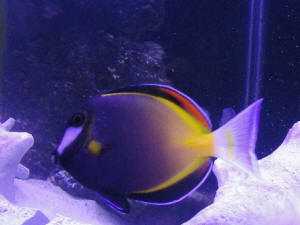
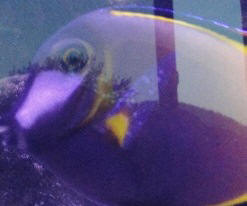 |
|
Re: Fowlr health MIRACLES IN IDAHO 7/10/12
Bob, It was a good day. Yesterday after I freshwater dipped my niger. I
thought it was the last time that I was going to see him alive. I came
home from work and he was swimming around!
<Ahh!>
One eye was clear and the other had one little speck on it. So I
freshwater dipped the Emperor. He looked as bad as the niger did
yesterday.
There had to be over 200 rice looking things exploding out of his gills.
<Interesting>
So it was flukes! I treated my tank with PraziPro today. I turned off
skimmer, charcoal reactor, and nitrate reactor. I am going to drop my
feedings to once a day. Only going to feed spectrum pellets. I was going
to do a water change Saturday and turn my skimmer and everything back
on. Is five days enough? Do you think this is the way to go? Should I
freshwater dip everyone? Do you think I am out of the woods?
<Can't say anything re>
Bob, I truly love this web site I have learned so much, but have so much
to learn. I just want to keep my fish alive for 15 to 20 years. We have
them all named, and there is damn near funeral in my house when one
dies. Kids are crying, I am crying, and the Wife could care less. lol
<... and so it goes. B>
Re: Fowlr health MIRACLES IN IDAHO, flukes?
7/14/12
Bob, I am proud to say that my tank has 100% recovered. Since adding
PraziPro, my Powder Brown lost the spots on his fins. My Emperor, and
Niger eyes have cleared up. There is no more scratching against the
rocks and sand. I wish I would of done this before my tank crashed, but
I will use this as a learning experience and move on. Thanks again,
Jim
<Ah, congratulations. B>
|
|
Question About Emperor Angelfish Discharge
5/30/11
Hello WWM Crew,
<Scott>
I wonder if I might ask your opinion about an issue with a
stringy discharge (poop) I have been noticing on my (roughly two
year old) Emperor Angelfish.
<I see these... likely Nematodes... Roundworms>
First, some data about my system for your reference - 135 gal SPS
which has been operating for about five years. Filtration
consists of a Euro-Reef Skimmer (with daily skimmate production
of about 1 dark cup) and an Eco-System 3616 mud refugium, loaded
with live rock and Chaetomorpha. Flow in the main display is
supplemented by four Vortech pumps, one of which flows directly
over another mass of Chaeto. The aragonite sand bed is roughly
3/4 inch and the aquarium contains about 150 lbs of live rock.
New pieces of live rock are "rotated" through the
system (following 6 week minimum quarantine). Lighting is a
mixture of HQIs, VHOs and LED.
Nitrate and Phosphate is undetectable, salinity and temperature
are at 35 ppt and 81 F, respectively.
I have the same five fish for over two years; in addition to the
emperor angel, there is a purple tang, flame angelfish, bicolor
blenny and a sunrise Pseudochromis.
Due to the refugium and the Chaeto in the display, there is a
generally a supply of various copepods and tiny brittle stars for
foraging by the fish, especially in the morning when the lights
first come on. They also tend to graze on the Chaeto, and some
other green macroalgae in the tank (I can't quite
identify).
Supplemental feeding to date has mainly been large freshwater
Mysis shrimp.
Generally speaking, the system is stable and all life thriving
(of course, now with the exception of the subject of this email).
Thanks in part to the strict quarantine regimen (learned from
your web site - thank you) I have never had any health issues
with these fish, but over the past few weeks I have noticed
the telltale "stringy discharge" from my emperor (photo
attached) which may indicate an infestation of some type of
parasite. But I hesitate to take a drastic action at this time
without it being warranted. The Emperor is plump, active, has a
very healthy appetite and vibrant color. The same can be said of
all the other fish.
<Often such parasitic situations are not "that"
debilitating. Successful parasites don't kill their
hosts>
One thing that occurs to me is that the discharge is not one fine
white "thread" which always seemed typical, but
"clumps" these white strands. Is this typical or do you
think this could be something else? Is there a possibility that
ingesting the Chaeto may be a contributing factor.
<Mmm, maybe... looking at some of these threads through a low
power microscope would allow you to be sure... cross sectioning
the cephalic region of Nematodes is definitive...>
Currently, I am drastically reducing the freshwater Mysis and
supplementing their diet with herbivore mix (Formula 2 and other
similar preparations) and monitoring for any changes. I don't
know
<Read here: http://wetwebmedia.com/rndwrmfaqs.htm
and here re treatment: http://wetwebmedia.com/vermifugefaqs.htm
Bob Fenner>
|
|
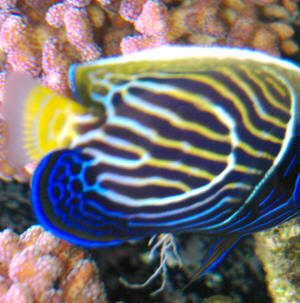
|
Zebra moray internal parasitic worms
4/30/11
Greetings,
I recently acquired a zebra moray, approximately 24 inches in length,
estimated 700 grams + in weight. The eel was purchased in distress, it
was housed in a 20 l
<!>
tank with at least 6 other eels of varying size and species... After
drip acclimating the eel and placing in a hospital tank where it's
been for 4 days now, I have noticed that it has parasitic worms
internally, one exited the eels rectum and was approximately 3 in in
length. The eel is in distress as it does not move much, will not eat
and has a mild bit of cloudiness it's eyes.
<The last will clear/heal of its own accord w/ time, good
conditions, nutrition>
I realize that this may be a lost cause but I am not willing to give up
just yet.
<Good... can/should be force fed a bolus of food laced with an
Anthelminthic. See here re: http://wetwebmedia.com/vermifugefaqs.htm
The water param.s are as follows
Ammonia, 0
Nitrate 0
Nitrite 0
Ph 8.3
Salinity 1.025
Temp 75 I'm not sure what the best medication would be to begin
treating this poor animal would be, Any possible advice would be
greatly appreciated,
Tim butler
<And look for Marcel's sep. resp. here. Bob Fenner>
Re zebra moray internal parasitic worms 5/1/11
Greetings,
<Hello.>
I recently acquired a zebra moray, approximately 24 inches in length,
estimated 700 grams + in weight. The eel was purchased in distress, it
was housed in a 20 l tank
<Some number missing here?>
with at least 6 other eels of varying size and species... After drip
acclimating the eel and placing in a hospital tank where it's been
for 4 days now, I have noticed that it has parasitic worms internally,
one exited the eels rectum and was approximately 3in in length.
<Did you take a picture or try to determine what type of worm it
was?>
The eel is in distress as it does not move much, will not eat and has a
mild bit of cloudiness on its eyes.
<Not eating can be related to stress due to moving here, cloudiness
can be bacterial, though.>
I realize that this may be a lost cause but I am not willing to give up
just yet.
<Me neither.>
The water param.s are as follows
Ammonia 0; Nitrate 0; Nitrite 0; Ph 8.3; Salinity 1.025; Temp 75
<Keep the water parameters stable, also provide sufficient gaseous
exchange with a skimmer and/or circulation pumps (stream or powerhead)
providing surface movement. Also offer caves for the eel, so it can
hide, which will reduce stress.>
I'm not sure what the best medication would be to begin treating
this poor animal would be, any possible advice would be greatly
appreciated,
Tim butler
<I'd go with a Praziquantel containing product here, since the
type of possible worm infestation is unknown (e.g. Parasite Clear,
PraziPro...).
Keep the water clean and if the eel should start feeding add vitamins
to its food... oh, and: good luck. Marco.>
Re zebra moray internal parasitic worms 5/1/11
No number missing there 20l tank... No filtration, skimmer... I would
have liked to get them all, but in reality I could not have housed them
for the long term, so went with the biggest..
My hospital tank is a bit larger, 40l I know this isn't great,
<It's not highly probable it will eat in such small quarters. I
also guess you'll have to do daily water changes to keep the water
quality stable and do recommend to use a skimmer to keep the oxygen
high.>
but after recovery it will be housed in a 1500 l he's moving a bit
today, not much though, so I'll start searching for the meds, as
I'm not sure what is available here in Thailand.
<A number of Praziquantel containing meds are certainly available in
Thailand given all the aquaculture facilities in this country. If the
product does not come with directions use about 25 mg per pound of
moray
(added to food (e.g. a clam, mussel, crab or shrimp), a bath would need
a higher concentration). Repeat a week later. Cheers,
Marco.>
|
intestinal worm id 1/30/11
Hi There Helpful WWM Crew!
<Howdy Vince! Sorry for the delayed resp.. Was out on an
ersatz overnight campout>
I am back for a second time, another fish needs help and I am
inexperienced at this problem. I have attached photos of the worm
that I observed hanging it's ugly head from the vent of our
newest resident, a P. Euxiphipops navarchus (4 inch size).
<A nice specimen! Is this one from Bali?>
The fish eats heartily, was not treated in QT, just observed. He
ate well and proved to be ok in a 55 with rock and sand for over
8 days so we added him in. He quickly adjusted, with some minor
aggression from our blue tang, Foxface and Spotfin butterfly. He
is in a 180 AGA mixed reef and has not picked on my invert
friends yet. I am hopeful. He eats Selcon enriched Nori, pe Mysis
and Hikari Mysis. He also eats pellets and formula 2 frozen. So
far we are very happy. I noticed the worm today, snapped
pictures, fed him and the worm departed, floated around the tank
and got lost in the rockwork before I could net it. It was almost
1 inch long and pink to red in color.
<I see this>
I am unsure of id but think both ends were pointed.
<Ahh! Likely a Nematode species... do see here in the FW
sect.:
http://wetwebmedia.com/FWSubWebIndex/nematodesfwf.htm
and the marine: http://wetwebmedia.com/rndwrmfaqs.htm
and here re treatment: http://wetwebmedia.com/fshwrmidcuref.htm
It oriented into the current while poking out of the fish, which
is why it caught my eye so quickly. This was not fecal matter for
sure. I am really happy to have found a well adjusted specimen of
this species (5 months at my local store). I drooled over him the
whole time.
My other fish don't show signs of intestinal parasites, but I
read Prazi in the food is the way to go if they all eat well. My
fish all eat well. I hope to treat while they are in the display,
as I have no QT big enough for all of the fish at once. Please
help or suggest a best course.
<I would treat via the foods as you state>
I am surprised the worm took off. Maybe this is a sign that
nature took care of it and not to worry?
<I would treat...>
Yeah Right, I should be so lucky.
Vincent M. Manfredi
Fisheries Biologist
<BobF, academically a fisheries biologist... marginally a
pet-fish ichthyologist>
|
|
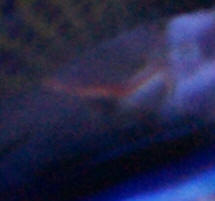 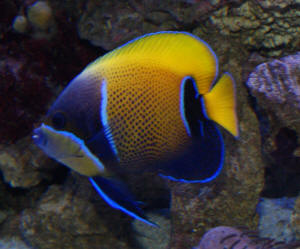
|
Re: Parasite Problems... RMF couldn't find prev.
corr. 11/29/09
Thank you again!
<Hello again Ashley, and sorry for my delay this time around>
I just returned from my trip and things look somewhat better.
<Good!>
The Xenia is still drooping and slightly shriveled up but better than
before, and the Cardinalfish doesn't look any better (it even looks
like its scales are swollen now), but the other fish show no signs of
disease.
<May be time to find other accommodations for the Cardinal, at least
until he/conditions improve>
We experienced a freeze while I was away, so my temperature has dropped
from 80 F to around 75 F.
<A drastic change, and a bit low, but should be ok.>
I will slowly bring that up today, as well as the salinity.
<Good>
I plan to do a water change tomorrow (Saturday) when the stores open up
so I can get more RO water. Is there anything I can do to help my
Cardinalfish? I do not have a quarantine tank, and unfortunately would
not be able to get one up and running quickly enough.
<All it takes is saltwater, a spare tank, and due diligence on
maintenance... can be done on the fly quite quickly.>
I do plan to look into having one in the future, so any suggestions for
this?
Ashley
<If space allows, bigger is always better, but for a tight pinch, an
air-driven corner filter, heater, and 10 gallon standard aquarium will
do just fine. You should be able to part together a cheap and simple QT
system for under $50 from just about any LFS in the country... this
would be my recommendation at this point on the Cardinal, without
something more specific (pictures, etc).. Do keep up on the water
changes, and let us know if you have any more questions!
-JustinN>
Re: fish disease?
I recently treated the tank with PraziPro, this time making sure I
followed the instructions to the tee. The Tomini tang is disease free
and so are the clowns but the male trigger has numerous reoccurring
spots on him.
<So... these marks not likely "worms">
The spots have been behaving the same as when the tank was not treated;
they are appearing as specs then turning to smears and then
disappearing and becoming new specs. The female trigger is looking a
little better but she still has a few specs, but nothing like the male.
I can tell the disease is not spreading because the rest of the fish
are free of any blemishes.
Also, the triggers are behaving perfectly normal. The owner of the
shop, in which I do business with, has suggested dipping the triggers
in fresh water to get rid of the disease since it is only affecting
them, and not
attacking the other fish. He recommended that I shoot you another
e-mail to gain your input on this method of treating the triggers.
Thank you,
Chris
<Such dips/baths can be efficacious. Read:
http://wetwebmedia.com/dips_baths.htm
and the linked files above. B>
re: fish disease?
I did get the response. Thank you for your input. My last e-mail was a
little like the first one, but instead I was wondering what you thought
about dipping the triggers since they are the only ones in the tank
being
attacked by the disease.
Chris
<... IF you have some other system to move them to
after...>
White Face Tang Parasites, flatworm-city
8/12/09
Greetings:
<Salud>
I acquired a White Face Tang about a week ago. It is in a quarantine
tank and is doing well, eating PE Mysis and Nori. A couple of days ago
I noticed a string shaped white parasite near one of its eyes. This
parasite is about 1/16 of an inch long with a diameter of about 1/3
that amount.
Today there are several more in the same area. Any ideas?
<Look for the two little eyes...>
It does not look like crypto or Oodinium nor does it seem to bother the
fish. No scratching.
<Mmm, there have been a "rash" of flatworm parasites
amongst this and other related species imported in recent months... A
friend/tenant/LFS owner whom I traveled with last week to LA told me of
travails with this worm... Can be sort of easily dislodged via simple/r
FW dips (read here re:
http://wetwebmedia.com/dips_baths.htm and the linked files above) or
the use of an anthelminthic...
http://wetwebmedia.com/fshwrmdisflukef.htm>
I'm about to go with a freshwater dip followed by copper unless you
advise against it.
Thanks,
Mark
<Not copper... Read, understand, then act. Bob Fenner>
Re: White Face Tang Parasites
Hello Bob and or Crew:
Thanks for the advice against the use of copper on what appear to have
been some sort of flatworm or fluke. I mistakenly assumed that copper
would eliminate any invertebrate
<Mmm, it will; but enough will eliminate all vertebrates!>
when in fact there are better medications for these parasites. I
administered a freshwater dip followed by Prazi-Pro for 5 days. The
parasites were eliminated.
<Ahh, good>
Now at three weeks in quarantine there appears to be another problem.
The respiration rate of the tang seems to be elevated.
<May be simple stress here. I'd move this fish to the main
display>
It eats PE Mysis and whatever it can find growing in the tank but is no
longer interested in dried algae of any kind. Could this be indicative
of stress due to captivity in a small tank or is there another parasite
on the gills choking off oxygen?
<Much more likely the former>
The qt tank is 10 gallons, small for a 3"-4" fish and I plan
on going to a 20 gal. Should I do this now or should I assume there is
a parasite at work here and begin treatment with copper? There is no
external manifestation of ich.
Thanks again,
Mark.
<I would "do this now". BobF>
| ID - Please Can you tell me what is hanging
from my purple tangs rear end?? It's certainly not the usual
muck. Thank you, Julie. <Mmm, appears to be a good-sized mass of
worms... likely Nematodes... though it might be Acanthocephalans...
I would be treating this fish/system with a vermifuge... Likely
Levamisole... please see WWM re such. Bob Fenner> |
|
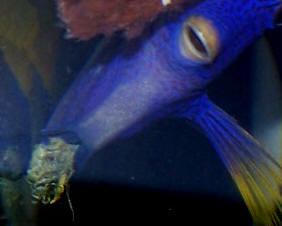 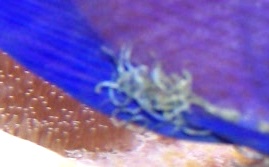
|
Nematode treatment, not Cu 11/4/07 Dear Crew,
<Mark> My yellow tang appeared to have "small strings"
coming from its vent. I merely observed for 3 weeks, but the fish
started to hide excessively and become lethargic. Water tests showed
good water quality: pH=8.1 in a.m. - 8.4 in p.m. Hardness=9dGH
Ammonia=0 Nitrite=0 Nitrate<5ppm Phosphate<.5ppm So I captured
the tang and put him in a quarantine tank and treated with .50ppm ionic
copper. <Mmmm, I would not have done this> I know tangs don't
always do well with copper, but I like using it because I can test how
much is present vs. " the dumping and hoping you added enough/not
too much" method associated with most other treatments. <Good
point> I did not try a freshwater dip because I have had poor
luck/skill with its use . Anyway, my yellow tang seems to be responding
well to the treatment so far (2 days). So how long should the tang be
treated? And how long should the display tank (90 gallon reef) remain
fallow? Thanks, Mark <If you had a microscope... I would cease the
copper exposure and try an anthelminthic here instead... in both the
treatment and main tank... Prazi-.... see WWM re. Bob Fenner>
|
Coppering White Face Tang.( Acanthurus
japonicus). Crypt... And flukes... 10/23/07 Last Monday I
purchased what appeared to be a healthy, eating and active white
face tang from my LFS. After bringing him home, giving a FW dip
with Methylene blue, acclimating and placing in my QT. I noticed
a small thread like thing hanging from his fin. I believe this
was an anchor worm. <Mmm> Over the next four days I did 2
more FW dips (I always use Methylene blue). The worm never
detached. But I did notice a few small critters in the rinse
container afterwards. I've got pics of these and will attach
them for you. I was able to view them through my handy dandy
kiddy CSI lab microscope at 200 mag. <Neat!> Even able to
get a pic through the microscope with my wife's digital
camera on macro setting. Kinda neat to see. I'll post it
also. But these aren't really the subject of my question, as
Friday afternoon I noticed the spots indicative of ick. I began
coppering Saturday morning. Using Cupramine. I am now up to the
recommended .50 ppm dosage and want to be sure I do this delicate
fish right. Is this what dosage you would suggest for this fish
with this product? <For this product, how the active
ingredient is measured, this is about right> Or do I need to
lower it down? I noticed somewhere here you recommended a lower
dosage? But with Cupramine? The directions say .50. <Keep it
near this... measure at least daily> I brought that up over 48
hours as directed. Also I though I saw where you recommended not
using continuous copper on this fish. <Yes... there are
other/better medicants to use on/with Acanthuroids> Does that
mean only with baths? <Another viable approach, yes> Or can
I continue with the 14 day treatment as indicated? <You can...
will be debilitating> I would like to actually remove the fish
as soon as possible from the QT to the DT. Not in a rush here,
but trying to do the right thing and limit exposure. As well as
guaranteeing an Ick free DT. I do not want to go down that road
again! I'll do whatever it takes to guarantee my 125 and 65
stays ick free. But If I treated the powder brown for 7 days and
then removed him and placed it in the 125. Would that cover my
bases here. <I would at least add a pH adjusted FW and
Formalin dip/bath twixt the QT/TT and DT here> It seems to me
I would be killing any ick that are free swimming (I forget the
term). Trying to attach now. So in 7 days then all ick would have
dropped off and not allowed to attach again. Thereby assuring a
properly timed "transfer". Of course I'll continue
the treatment of the QT for the duration to guarantee its safe
for the next addition. If this looks like a viable option, I
would like to use it. But wont risk the infestation of the 125.
If its OK to treat it for the 14 days and this isn't a viable
option, I'll continue this coarse. <course> Thank You
so very much for your help. You site has been an incredible
contribution to my success in this hobby. Charlie Bunch <In
the meanwhile I'd read re the causative organism, it's
treatment... Here: http://www.wetwebmedia.com/ichart2mar.htm and
the many linked files above. Bob Fenner>
|
|
.jpg) 
|
|
|

